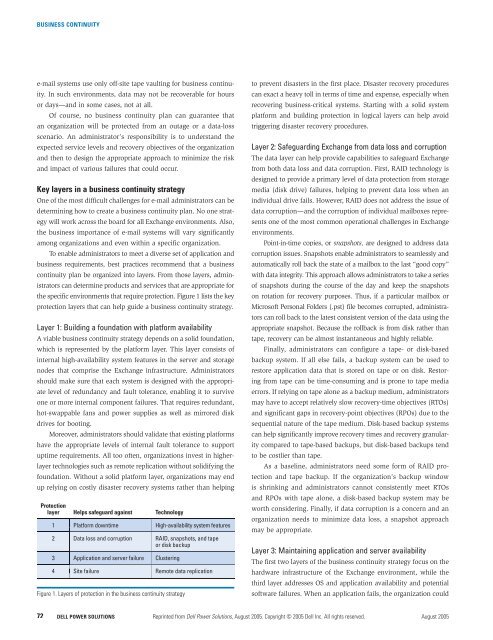POWER SOLUTIONS
POWER SOLUTIONS
POWER SOLUTIONS
Create successful ePaper yourself
Turn your PDF publications into a flip-book with our unique Google optimized e-Paper software.
BUSINESS CONTINUITYe-mail systems use only off-site tape vaulting for business continuity.In such environments, data may not be recoverable for hoursor days—and in some cases, not at all.Of course, no business continuity plan can guarantee thatan organization will be protected from an outage or a data-lossscenario. An administrator’s responsibility is to understand theexpected service levels and recovery objectives of the organizationand then to design the appropriate approach to minimize the riskand impact of various failures that could occur.Key layers in a business continuity strategyOne of the most difficult challenges for e-mail administrators can bedetermining how to create a business continuity plan. No one strategywill work across the board for all Exchange environments. Also,the business importance of e-mail systems will vary significantlyamong organizations and even within a specific organization.To enable administrators to meet a diverse set of application andbusiness requirements, best practices recommend that a businesscontinuity plan be organized into layers. From those layers, administratorscan determine products and services that are appropriate forthe specific environments that require protection. Figure 1 lists the keyprotection layers that can help guide a business continuity strategy.Layer 1: Building a foundation with platform availabilityA viable business continuity strategy depends on a solid foundation,which is represented by the platform layer. This layer consists ofinternal high-availability system features in the server and storagenodes that comprise the Exchange infrastructure. Administratorsshould make sure that each system is designed with the appropriatelevel of redundancy and fault tolerance, enabling it to surviveone or more internal component failures. That requires redundant,hot-swappable fans and power supplies as well as mirrored diskdrives for booting.Moreover, administrators should validate that existing platformshave the appropriate levels of internal fault tolerance to supportuptime requirements. All too often, organizations invest in higherlayertechnologies such as remote replication without solidifying thefoundation. Without a solid platform layer, organizations may endup relying on costly disaster recovery systems rather than helpingProtectionlayer Helps safeguard against Technology1 Platform downtime High-availability system features2 Data loss and corruption RAID, snapshots, and tapeor disk backup3 Application and server failure Clustering4 Site failure Remote data replicationFigure 1. Layers of protection in the business continuity strategyto prevent disasters in the first place. Disaster recovery procedurescan exact a heavy toll in terms of time and expense, especially whenrecovering business-critical systems. Starting with a solid systemplatform and building protection in logical layers can help avoidtriggering disaster recovery procedures.Layer 2: Safeguarding Exchange from data loss and corruptionThe data layer can help provide capabilities to safeguard Exchangefrom both data loss and data corruption. First, RAID technology isdesigned to provide a primary level of data protection from storagemedia (disk drive) failures, helping to prevent data loss when anindividual drive fails. However, RAID does not address the issue ofdata corruption—and the corruption of individual mailboxes representsone of the most common operational challenges in Exchangeenvironments.Point-in-time copies, or snapshots, are designed to address datacorruption issues. Snapshots enable administrators to seamlessly andautomatically roll back the state of a mailbox to the last “good copy”with data integrity. This approach allows administrators to take a seriesof snapshots during the course of the day and keep the snapshotson rotation for recovery purposes. Thus, if a particular mailbox orMicrosoft Personal Folders (.pst) file becomes corrupted, administratorscan roll back to the latest consistent version of the data using theappropriate snapshot. Because the rollback is from disk rather thantape, recovery can be almost instantaneous and highly reliable.Finally, administrators can configure a tape- or disk-basedbackup system. If all else fails, a backup system can be used torestore application data that is stored on tape or on disk. Restoringfrom tape can be time-consuming and is prone to tape mediaerrors. If relying on tape alone as a backup medium, administratorsmay have to accept relatively slow recovery-time objectives (RTOs)and significant gaps in recovery-point objectives (RPOs) due to thesequential nature of the tape medium. Disk-based backup systemscan help significantly improve recovery times and recovery granularitycompared to tape-based backups, but disk-based backups tendto be costlier than tape.As a baseline, administrators need some form of RAID protectionand tape backup. If the organization’s backup windowis shrinking and administrators cannot consistently meet RTOsand RPOs with tape alone, a disk-based backup system may beworth considering. Finally, if data corruption is a concern and anorganization needs to minimize data loss, a snapshot approachmay be appropriate.Layer 3: Maintaining application and server availabilityThe first two layers of the business continuity strategy focus on thehardware infrastructure of the Exchange environment, while thethird layer addresses OS and application availability and potentialsoftware failures. When an application fails, the organization could72DELL <strong>POWER</strong> <strong>SOLUTIONS</strong> Reprinted from Dell Power Solutions, August 2005. Copyright © 2005 Dell Inc. All rights reserved. August 2005








